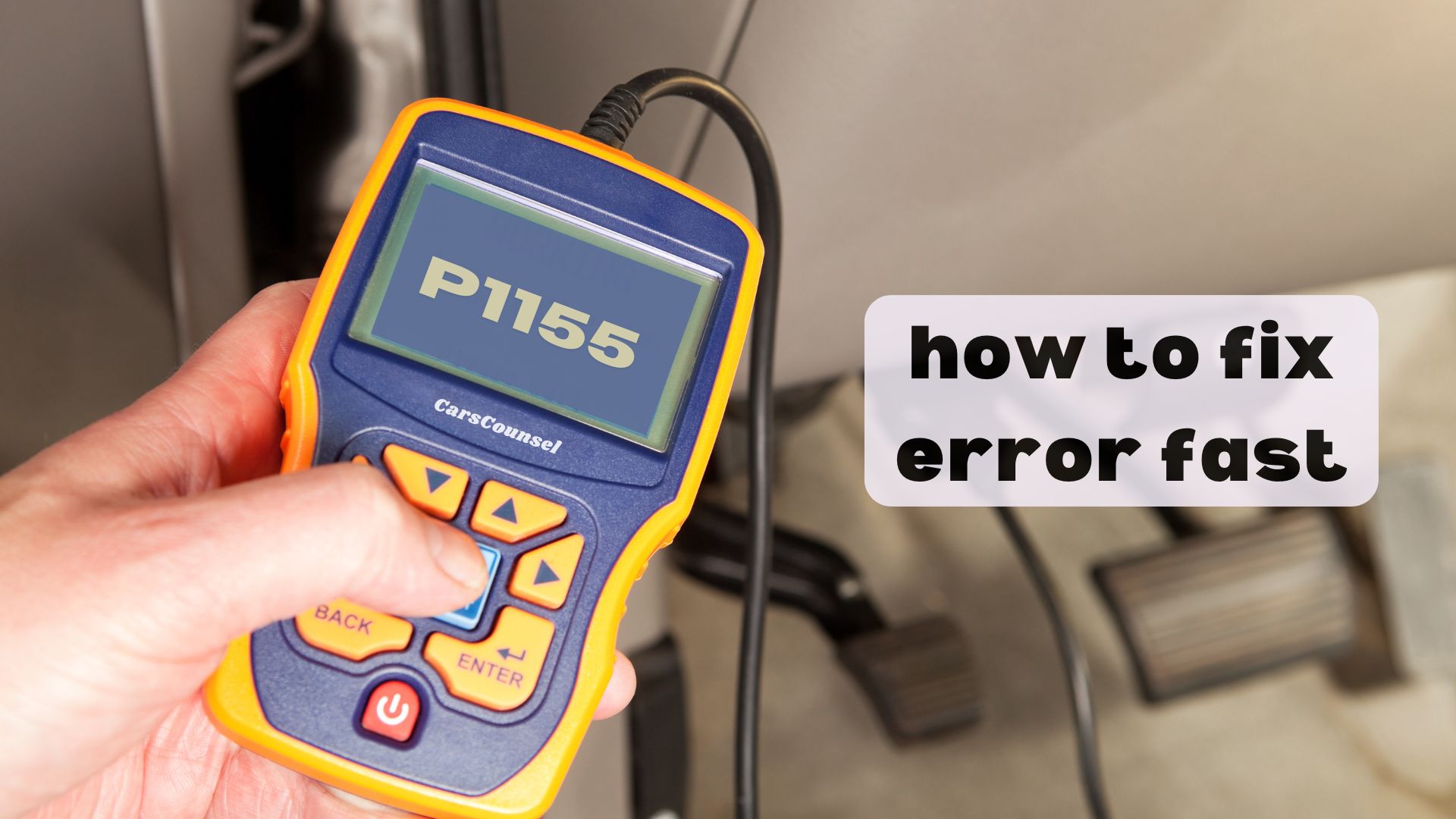When your car’s onboard computer spits out a P1155 code, it’s telling you there’s a problem with the air/fuel ratio sensor heater circuit for Bank 2 Sensor 1.
This sensor is vital for monitoring oxygen levels in the exhaust gases, and a malfunction can throw off the air/fuel mixture, leading to decreased fuel efficiency and rough idling. But what’s causing the issue?
Is it a faulty sensor, wiring problems, or something else entirely? You’ll need to dig deeper to find out.

Quick Navigation
Key Takeaways
- The P1155 code indicates a malfunction in the air/fuel ratio sensor heater circuit for Bank 2 Sensor 1, affecting engine performance and emissions.
- A faulty air/fuel ratio sensor can cause decreased fuel efficiency, rough idling, and increased emissions, making prompt repair essential.
- Common causes of the P1155 code include sensor failure, wiring issues, blown fuses, ECM malfunction, and environmental factors.
- Diagnosis involves using an OBD-II scanner, performing a visual inspection, and checking the heater circuit with a multimeter.
- Repair typically involves replacing the faulty air/fuel ratio sensor, inspecting and repairing wiring and connectors, and addressing environmental factors.
What Does the P1155 Code Mean?
The P1155 code indicates a malfunction in the air/fuel ratio sensor heater circuit for Bank 2 Sensor 1, which is a critical component of your vehicle’s emissions control system.
This sensor monitors oxygen levels in the exhaust gases and provides feedback to the engine control module. The heater circuit helps the sensor reach operating temperature quickly, especially during cold starts.
A faulty sensor can disrupt the air/fuel mixture, leading to decreased fuel efficiency, rough idling, and increased emissions. It’s essential to address this issue promptly to prevent further damage to your vehicle’s engine.
Common Causes of the P1155 Code
You’ve just diagnosed a P1155 code, which means your air/fuel ratio sensor heater circuit for Bank 2 Sensor 1 is malfunctioning. Now, it’s essential to identify the root cause of the issue. Common causes of the P1155 code include:
| Cause | Description |
|---|---|
| Sensor Failure | Faulty air/fuel ratio sensor prevents accurate readings |
| Wiring Issues | Damaged wiring or connectors in the heater circuit |
| Blown Fuse | Blown fuse related to the sensor heater prevents operation |
| ECM Malfunction | Malfunctioning engine control module affects sensor performance |
These causes can lead to inaccurate air/fuel mixture readings, affecting your vehicle’s performance and emissions.
Symptoms of a Faulty Air/Fuel Ratio Sensor
When your air/fuel ratio sensor malfunctions, it can cause a ripple effect on your vehicle’s performance, leading to noticeable symptoms.
You may experience decreased fuel efficiency, which can be frustrating and costly.
The faulty sensor can also cause your engine to run rich or lean, leading to:
- Rough idling or stalling
- Hesitation or loss of power during acceleration
- Increased emissions
- Illuminated check engine light
These symptoms can be a sign of sensor failure, leading to fuel inefficiency and decreased performance.
It’s essential to address the issue promptly to avoid further damage to your vehicle.
How to Diagnose the P1155 Code
Diagnosing the P1155 code requires a logical and methodical approach to identify the root cause of the malfunction. You’ll need to follow a step-by-step process to isolate the issue. Start by using an OBD-II scanner to confirm the fault code and check for any other related codes. Then, perform a visual inspection of the air/fuel ratio sensor and its wiring to look for signs of damage or corrosion.
| Diagnostic Step | Action | Purpose |
|---|---|---|
| Sensor Inspection | Visually inspect the sensor and its wiring | Identify signs of damage or corrosion |
| Heater Testing | Use a multimeter to test the heater circuit | Determine if the heater is functioning properly |
| Wiring and Connector Check | Inspect the wiring and connectors for damage or corrosion | Identify any issues that may be affecting the sensor’s operation |
Repairing the P1155 Code
One faulty component is all it takes to trigger the P1155 code, and repairing it requires a targeted approach.
To get your vehicle running smoothly again, you’ll need to identify and fix the root cause.
- Inspect the wiring and connectors for damage or corrosion
- Check for a blown fuse related to the sensor heater
- Perform sensor maintenance to guarantee accurate readings
- Address any environmental factors affecting sensor performance
Replacing the Air/Fuel Ratio Sensor
Replace the faulty air/fuel ratio sensor with a new one to guarantee precise readings and proper engine performance.
You’ll eliminate faulty symptoms like decreased fuel efficiency, rough idling, and hesitation during acceleration.
When replacing the sensor, verify you get an OEM or OEM-equivalent part to maintain the manufacturer’s specifications.
Follow the manufacturer’s instructions for sensor replacement, and take necessary precautions to avoid damaging surrounding components.
Proper sensor replacement will restore peak engine performance and prevent further damage to your vehicle’s engine.
Importance and Difficulty of the Repair
The repair importance level of 3 (High) assigned to the P1155 code indicates that addressing this issue promptly is crucial to prevent further engine damage and potential safety hazards.
You’ll want to prioritize this repair to avoid costly consequences down the road. When seeking a professional’s help, be prepared for a moderate-level repair complexity, which may influence shop estimates.
- Expect a few hours of labor to diagnose and repair the issue
- Be prepared for potential additional costs if other related components need replacement
- Multiple shop estimates can help you find a fair price for the repair
- A thorough inspection and diagnosis will guarantee the root cause is addressed
Additional Resources for Fixing the P1155 Code
About three essential resources can aid in fixing the P1155 code: quotes from multiple shops, access to factory service manuals, and a clear understanding of the typical repair cost.
You’ll want to gather repair estimates from various mechanics to guarantee you’re getting a fair deal. Factory service manuals provide detailed instructions on how to fix the code, and knowing the typical repair cost – between $200 to $500 – helps you budget accordingly.
Additionally, investing in diagnostic tools will help you identify and fix the issue efficiently.
More OBD-II Codes
| P1156 | P1157 | P1158 | P1159 |
| P1161 | P1163 | P1164 | P1165 |
| P1170 | P1171 | P1185 | P1189 |
| P1187 | P1190 | P1215 | P1216 |
| P1217 | P1218 | P1219 | P1220 |
| P1228 | P1234 | P1237 | P1231 |
Frequently Asked Questions
Can I Drive My Car With a P1155 Code?
You can drive your car with a P1155 code, but be aware that it may affect fuel efficiency and ignition timing, leading to decreased performance and potential damage to your engine; it’s recommended to address the issue as soon as possible.
Will a P1155 Code Cause Damage to My Engine?
Did you know that a faulty oxygen sensor can decrease your fuel efficiency by up to 40%? If left unchecked, sensor failure from a P1155 code can cause damage to your engine over time, as poor fuel efficiency can lead to excessive fuel consumption and engine wear.
Can I Replace the Air/Fuel Ratio Sensor Myself?
You can replace the air/fuel ratio sensor yourself, but be prepared to locate it in a potentially tight space, and inspect the wiring for damage or corrosion to guarantee a proper fix.
Do I Need to Reset the Engine Computer After Repair?
As you wrap up the repair, you’re wondering if you need to reset the engine computer. Yes, you’ll need to follow reset procedures or perform a Computer reflash to guarantee the system recalibrates and recognizes the new sensor, avoiding any lingering issues.
Will a Tune-Up Fix a P1155 Code?
You’re wondering if a tune-up will fix a P1155 code. Unfortunately, a standard tune-up typically only includes spark plug replacement and fuel injector cleaning, which won’t address the faulty oxygen sensor or heater circuit issue causing the code.
Conclusion
As you navigate the complex landscape of your engine, the P1155 code serves as a landmark, warning you of a malfunction in the air/fuel ratio sensor heater circuit. Think of it as a lighthouse on a rocky shore, guiding you through treacherous waters of engine trouble. By heeding its warning, you can avoid the shipwreck of decreased fuel efficiency and rough idling, and instead, chart a course for smooth sailing with a properly functioning engine.

